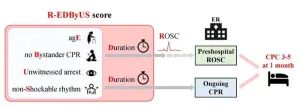(Press-News.org) A new generation of specialty optical fibres has been developed by physicists at the University of Bath in the UK to cope with the challenges of data transfer expected to arise in the future age of quantum computing.
Quantum technologies promise to provide unparalleled computational power, allowing us to solve complex logical problems, develop new medicines and provide unbreakable cryptographic techniques for secure communications. However, the cable networks used today to transmit information across the globe are likely to be sub-optimal for quantum communications, due to the solid cores of their optical fibres.
Unlike regular optical fibres, the speciality fibres fabricated at Bath have a micro-structured core, consisting of a complex pattern of air pockets running along the entire length of the fibre.
“The conventional optical fibres that are the workhorse of our telecommunications networks of today transmit light at wavelengths that are entirely governed by the losses of silica glass. However, these wavelengths are not compatible with the operational wavelengths of the single-photon sources, qubits, and active optical components, that are required for light-based quantum technologies.” said Dr Kristina Rusimova from the Department of Physics at Bath.
Dr Rusimova and her colleagues describe the state-of-the-art fibres made at Bath, along with other recent and future developments in the emerging field of quantum computing, in an academic paper published today in Applied Physics Letters Quantum.
Dr Rusimova, who is lead senior author of the paper – known as a perspective – added: “Optical-fibre design and fabrication is at the forefront of the University of Bath Department of Physics research, and the optical fibres we are developing with quantum computers in mind are laying the foundations for the data transmission needs of tomorrow”.
Quantum entanglement
Light is a promising medium for quantum computation. The individual particles of light, called photons, possess some uniquely quantum properties that can be harnessed by quantum technologies.
One such example is quantum entanglement, where two photons separated by a large distance not only hold information about one another but can also instantly influence each other’s properties. Unlike the binary bits of classical computers (either a one or a zero), pairs of entangled photons can in fact exist as both a one and a zero at the same time, unleashing enormous amounts of computational power.
Dr Cameron McGarry, until recently a physicist at Bath and first-author of the paper, said: “A quantum internet is an essential ingredient in delivering on the vast promises of such emerging quantum technology.
“Much like the existing internet, a quantum internet will rely on optical fibres to deliver information from node to node. These optical fibres are likely to be very different to those that are used currently and will require different supporting technology to be useful.”
In their perspective, the researchers discuss the associated challenges of the quantum internet from the viewpoint of optical fibre technology and present an array of potential solutions for scalability of a robust, wide-scale quantum network.
This encompasses both the fibres that will be used for long-range communication, and specialty fibres that will allow for quantum repeaters, integrated directly into the network in order to extend the distance over which this technology can operate.
Beyond connecting nodes
They also describe how speciality optical fibres can go beyond connecting nodes of a network to implementing quantum computation at the nodes themselves by acting as sources of entangled single photons, quantum wavelength converters, low-loss switches, or vessels for quantum memories.
Dr McGarry said: “Unlike the optical fibres that are standardly used for telecommunications, speciality fibres which are routinely fabricated at Bath have a micro-structured core, consisting of a complex pattern of air pockets running along the entire length of the fibre.
“The pattern of these air pockets is what allows researchers to manipulate the properties of the light inside the fibre and create entangled pairs of photons, change the colour of photons, or even trap individual atoms inside the fibres.”
“Researchers around the world are making rapid and exciting advancements in the capabilities of microstructured optical fibres in ways that are of interest to industry,” said Dr Kerrianne Harrington who is a postdoctoral researcher in the Department of Physics.
“Our perspective describes the exciting advances of these novel fibres and how they could be beneficial to future quantum technologies.”
Dr Alex Davis, an EPSRC Quantum Career Acceleration Fellow at Bath, added: “It's the ability of fibres to tightly confine light and transport it over long distances that makes them useful.
“As well as generating entangled photons, this allows us to generate more exotic quantum states of light with applications in quantum computing, precision sensing and impregnable message encryption.”
Quantum advantage – the ability of a quantum device to perform a task more efficiently than a conventional computer – has yet to be conclusively demonstrated. The technological challenges identified in the perspective are likely to open new avenues of quantum research, and bring us closer to achieving this important milestone. The optical fibres fabricated at Bath are expected to help lay the foundations for the quantum computers of tomorrow.
The team of researchers at Bath also included senior lecturer, Dr Peter Mosely.
END
Past studies have suggested that taking cholesterol-lowering statin drugs may lower individuals’ risk of developing liver cancer. In a new study of non-statin cholesterol-lowering medications, one type was linked to lower risks of liver cancer. The findings are published by Wiley online in CANCER, a peer-reviewed journal of the American Cancer Society.
Cholesterol absorption inhibitors, bile acid sequestrants, fibrates, niacin, and omega-3 fatty acids are types of non-statin cholesterol-lowering medications prescribed to manage cholesterol and lipid levels. The different classes ...
When it comes to treating cardiac arrest, acting quickly can mean the difference between life and death.
Researchers from Osaka Metropolitan University have developed a new scoring model, using only prehospital resuscitation data, that accurately predicts neurological outcomes of patients with out-of-hospital cardiac arrest (OHCA). This model potentially allows healthcare providers to make quick and accurate decisions upon the patient’s arrival at the hospital, ultimately improving patient care and resource allocation.
Their findings were published in Resuscitation on May 31.
Cardiac arrest can lead to death within minutes. OHCA is not uncommon and often results ...
In Canada, rates of hypertensive disorders of pregnancy (HDP) have increased, but the good news is there has been a decline in some related health conditions, according to new research published in CMAJ (Canadian Medical Association Journal) https://www.cmaj.ca/lookup/doi/10.1503/cmaj.231547.
Hypertensive disorders of pregnancy include chronic hypertension (high blood pressure), gestational hypertension, and preeclampsia or eclampsia. These disorders affect 5%–10% of pregnancies worldwide, and cause more than 50 000 maternal deaths and 500 000 deaths in fetuses and infants ...
Free genetic testing, offered partially or fully subsidized by industry, may have trade-offs, and health systems in Canada must carefully weigh potential clinical, ethical, and legal considerations to protect patient data, authors argue in a CMAJ (Canadian Medical Association Journal) commentary https://www.cmaj.ca/lookup/doi/10.1503/cmaj.231588.
“Near- and long-term expansion in no-cost testing and industry partnership in genetics, with patient data as the commodity, is likely,” writes Kirsten ...
Eating a vegan diet for eight weeks is associated with reductions in biological age estimations based on levels of DNA methylation — a type of chemical modification of DNA (known as an epigenetic modification) that alters gene expression but not DNA itself. Previous research has reported that increased DNA methylation levels are associated with ageing. The findings, which are based on a small randomised controlled trial of 21 pairs of adult identical twins, are published in BMC Medicine.
Varun Dwaraka, Christopher ...
Researchers in Australia have found that when women are given accurate information about a test that indicates the number of eggs in their ovaries, they have less interest in taking the test compared to women who viewed information available online.
The researchers initiated the study, which is published today (Monday) in Human Reproduction [1], one of the world’s leading reproductive medicine journals, because of the large amount of misleading and incorrect information promoted to women about the anti-Mullerian hormone (AMH) test on websites, including fertility clinic websites, and via social media.
AMH ...
A decarbonised steel industry that includes carbon dioxide removal techniques in its net zero arsenal could use lower-grade iron ore, according to a new study.
Steel accounts for 5-8% of carbon dioxide emissions globally. Its total emissions have risen over the past decade, largely due to increased demand.
The International Energy Agency has stated that, without innovation, the scope to limit emissions is ‘limited’. Therefore, the commercialisation of new zero-emission production processes is critical.
Innovative ...
About The Study: The results of this cohort study suggest that combining plasma p-tau217 and Aβ42/40 levels could be useful for predicting development of Aβ pathology in people with early stages of subthreshold Aβ accumulation. These biomarkers might thus facilitate screening of participants for future primary prevention trials.
Corresponding Authors: To contact the corresponding authors, email Oskar Hansson, M.D, Ph.D. (Oskar.Hansson@med.lu.se) and Shorena Janelidze, Ph.D. (shorena.janelidze@med.lu.se).
To access the embargoed study: Visit our For The Media website at this link https://media.jamanetwork.com/
(doi:10.1001/jamaneurol.2024.2619)
Editor’s ...
About The Study: In this cohort study, seed amplification assays (SAA) α-syn+ was consistently associated with nucleus basalis of Meynert (NBM) atrophy already during asymptomatic stages. Further, in memory clinic cognitively impaired populations, SAA α-syn+ was associated with NBM atrophy, which partially mediated α-syn–induced attention/executive impairment.
Corresponding Authors: To contact the corresponding authors, email Laura E.M. Wisse, Ph.D. (laura.wisse@med.lu.se) and Oskar Hansson, M.D., Ph.D. (oskar.hansson@med.lu.se).
To access the embargoed study: Visit our For The Media website at this link https://media.jamanetwork.com/
(doi:10.1001/jamaneurol.2024.2713)
Editor’s ...
About The Study: The amyloid probability score 2 (APS2) blood test and percentage of p-tau217 alone had high diagnostic accuracy for identifying Alzheimer disease among individuals with cognitive symptoms in primary and secondary care using predefined cutoff values. Future studies should evaluate how the use of blood tests for these biomarkers influences clinical care.
Corresponding Authors: To contact the corresponding authors, email Sebastian Palmqvist, M.D., Ph.D. (sebastian.palmqvist@med.lu.se) and Oskar Hansson, M.D., Ph.D. (oskar.hansson@med.lu.se).
To access the embargoed study: Visit our For The Media website at this link https://media.jamanetwork.com/
(doi:10.1001/jama.2024.13855)
Editor’s ...





